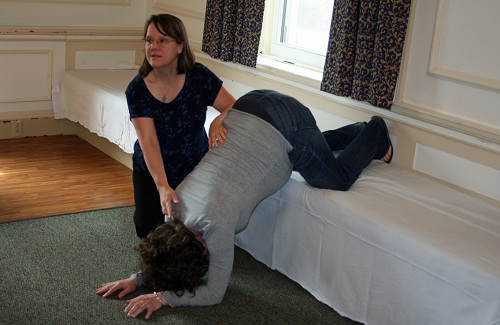The ideal position of the fetus to make childbirth relatively complication-free is to have the baby with the head down into the pelvis and facing towards your back. Usually as babies grow in the womb, they turn and twist, but towards the end of the pregnancy, they settle into the ideal position for the birthing process. This usually happens naturally around week 36 of the pregnancy. However, this does not always occur. About 3% of babies remain in the breech position at full term. Tips to turn your breech baby are available below.
How to Turn a Breech Baby
There are a few exercises you can do with your doctor’s permission between weeks 30-37 of your pregnancy. If you feel faint or pain during these exercises, stop immediately.
1. Perform the Breech Tilt
 Lie down on a flat surface and prop your hips up about 10 inches higher than your head. You can either use pillows or a broad piece of wood to achieve this. Remember to do this as safely as possible. If you’re using a board, ensure the board is secure against whatever it is leaning against. Repeat this exercise for about three times per day. Lie down each time for about 15 minutes. Do this on an empty stomach and when the baby is active. Lie as relaxed as possible, breathing deeply.
Lie down on a flat surface and prop your hips up about 10 inches higher than your head. You can either use pillows or a broad piece of wood to achieve this. Remember to do this as safely as possible. If you’re using a board, ensure the board is secure against whatever it is leaning against. Repeat this exercise for about three times per day. Lie down each time for about 15 minutes. Do this on an empty stomach and when the baby is active. Lie as relaxed as possible, breathing deeply.
2. Knee to Chest Exercise
 Kneel on the floor or a bed. Bring your forearms onto the ground. In this position, your lower uterus will expand, allowing easy turning of the baby. You can even lightly push upwards from your pubic bone onto the baby’s rear end using one hand while the other hand is still on the floor supporting you. Perform this position also on an empty stomach for about twice a day. Hold the position in between 5-15 minutes.
Kneel on the floor or a bed. Bring your forearms onto the ground. In this position, your lower uterus will expand, allowing easy turning of the baby. You can even lightly push upwards from your pubic bone onto the baby’s rear end using one hand while the other hand is still on the floor supporting you. Perform this position also on an empty stomach for about twice a day. Hold the position in between 5-15 minutes.
3. Forward Leaning Inversion
 This pose is similar to knee to chest exercise, however, the stretch is a bit more intense. Have a friend or your partner support you for safety. Kneel on the bed or an elevated flat surface. Place your palms down onto the floor. Tucking your chin towards your body helps relax the pelvis further. This brings your pelvis even higher. Due to the strenuous nature of the pose, perform only for 30 seconds about 3 times per day.
This pose is similar to knee to chest exercise, however, the stretch is a bit more intense. Have a friend or your partner support you for safety. Kneel on the bed or an elevated flat surface. Place your palms down onto the floor. Tucking your chin towards your body helps relax the pelvis further. This brings your pelvis even higher. Due to the strenuous nature of the pose, perform only for 30 seconds about 3 times per day.
4. Mild Exercise
Mild exercise like swimming or walking may stimulate the baby into the correct position. You can also try sitting on an exercise ball to open up the pelvic area.
5. Yoga
Some poses designed for pregnant women encourage a good baby position. However, these poses have to be practiced throughout your pregnancy rather than only towards the end.
6. Sound or Light
Play classical music to stimulate the baby near your pubic bone. A flashlight may be used to turn the baby in the right direction. Point the light towards your lower uterus.
7. Hot-Cold Method
Besides exercises, there are other ways available when you’re learning how to turn a breech baby. Placing cold items, like a bag of frozen peas, near the head of the baby may cause the baby to shift away to escape from the coldness. Alternatively, you can use a warm pack near the lower part of your pelvis so that your baby could move towards the heat.
8. Webster’s Technique
An experienced, licensed chiropractor can perform Webster’s technique. This technique ensures the pelvic basin is correctly aligned and the ligaments supporting the uterus are relaxed enough. The baby’s position will not change after just one visit. You may have to see the chiropractor about three times per week in the final stages of your pregnancy.
9. Traditional Chinese Herbs
A licensed acupuncturist burns an herb called mugwort to stimulate the baby into moving with the technique called moxibustion.
10. Hypnosis
A licensed hypnotherapist has been known to successfully turn breech babies. It succeeds in helping the mother relax and to visualize the baby turning.
Watch the following video and learn more tips to turn a breech baby:
What If My Baby Doesn’t Turn?
If all the above techniques have failed after your 37th week of pregnancy, it is best to seek your doctor’s advice on how to turn a breech baby.
1. External Cephalic Version
Your doctor may perform an external cephalic version (ECV). This entails using a muscle relaxant which relaxes the uterus and the doctor pushing the baby into position externally. This procedure is performed using an ultrasound so the doctor can monitor the baby’s position constantly.
2. Caesarean Section
Caesarean section is a surgery to deliver the baby through the incision in the lower abdomen. You can discuss with your doctor about scheduling a Caesarean section which is less risky when you’re approaching your due date while the baby is still in a breech position. Almost 90% of breech babies are delivered by Caesarean section.
3. Breech Vaginal Delivery
If you can’t find out how to turn a breech baby, discuss with your doctor about if vaginal delivery is possible for you. If your pelvis is wide enough, you don’t have complications and your baby’s position is not footling (feet below bottom), vaginal delivery might be a viable option. If your baby is still in the breech position on the delivery day, remain relaxed and your medical practitioner will be able to work out the best decision with you. The position of your placenta, your birthing experiences, the size of your baby, the width of your pelvis and your underlying medical conditions such as preeclampsia will all be taken into consideration.
